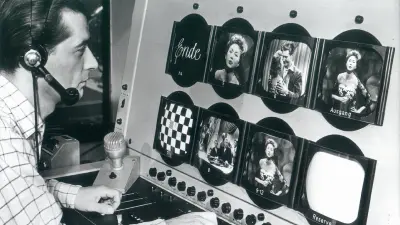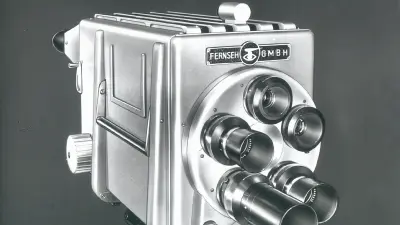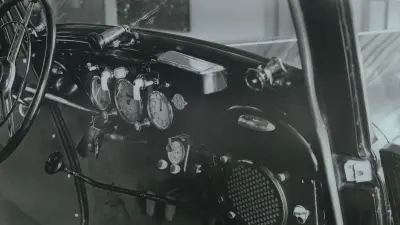TV at Bosch
The history of Fernseh GmbH
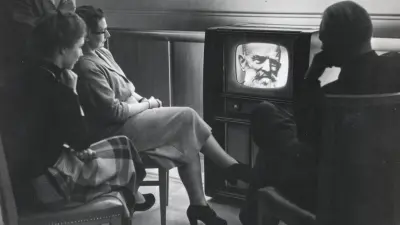
It took a healthy dose of idealism for the TV pioneers of the 1920s to achieve success so quickly. The idea of transmitting and receiving moving pictures seemed too adventurous, the technology behind it too subtle and novel. But the engineers at Fernseh AG, founded in 1929 with the participation of Bosch, would not be deterred. As early as the early 1930s, they pioneered electronic image rendition, which was groundbreaking for the further development of television.

The fundamental technical prerequisites for television had been known since 1884, when Paul Nipkow was granted the first television patent. Using the eponymous Nipkow disk, an image could be scanned line by line, translated into a transmissible electrical signal, and then reassembled.
After many attempts and further developments, television was on the verge of being launched in the late 1920s. In Germany, the telegraphy department of the German postal service had officially taken over responsibility for supporting television in 1928, and television sets had been unveiled in the fall of that year at the fifth annual radio exhibition (now the IFA) in Berlin. The new medium seemed promising, but it was extremely sophisticated in technical terms, so it seemed obvious to bring specialists from various fields together to make it a reality.
Fernseh AG marks initial successes
On June 11, 1929, four companies teamed up to form Fernseh AG in Berlin. Baird Television Ltd., which was based in London, had experience with scanning images and electro-optical converters, and D.S. Loewe, from Berlin, had expertise with electronic amplifier technology. Bosch contributed its knowledge of precision mechanics and measurement technology, and Zeiss Ikon AG from Dresden, drew on expertise in optical and photographic methods.
The newly founded company made its first big appearance just three months later. At its very own booth at the sixth annual radio exhibition in Berlin, the company presented a functional television receiver, but one that never went into mass production, contrary to the official announcement. Another success came with the development of a film scanner to transmit normal film via television. It made it possible to transmit relatively clear, flicker-free images, but still struggled with inadequate brightness.
This problem was finally solved by the cathode ray tube. Inside each vacuum tube, a beam of electrons struck a phosphorescent screen to reproduce an image. A high vacuum department had been established at Fernseh AG in 1932, testing and finally incorporating cathode ray tubes into receivers. The fully electronic high vacuum tube delivered much brighter, clearer images. It went on to become the worldwide standard.

Television leaves the studio
Still, good television images could only be transmitted from darkened studios, as the light beam scanners did not work outdoors in natural light. To solve this problem and broadcast television images of outdoor events, Fernseh AG began developing the intermediate film system in 1931. In this system, scenes were captured using a normal film camera, the film was immediately processed and developed, and then it was scanned again and transmitted. The delay between recording and playback was just 15 seconds, so the audience could watch in near real time.
The first big public television broadcasts took place at the 1936 Olympics, in Berlin. A television recording truck with an intermediate film system from Fernseh AG broadcast the events from various venues; an early fully electronic iconoscope camera from competitor Telefunken was installed inside the stadium. The sporting events generated a lot of interest, with about 160,000 viewers gathering around receivers in both private homes and special public viewing lounges over the course of the games.

The enthusiasm for sports was overlaid by the Nazi regime’s propaganda machine, which used not only the Olympics, but also daily television programming, for its own ends. After the Nazis seized power, in 1933, the development of television received increasing support from the state. Between then and the outbreak of the war, in 1939, when public television in Germany was halted, the television companies faced recurring interference from various Nazi government agencies.
This was also the broader context for changes that took place among the partners in Fernseh AG. Baird, as a British-owned company, and Loewe, whose founder was of Jewish ancestry, were squeezed out of the company. Bosch and Zeiss Ikon did not challenge the move. In 1939, Bosch acquired Zeiss Ikon’s shares and converted Fernseh AG into a limited liability company.
Television catches on
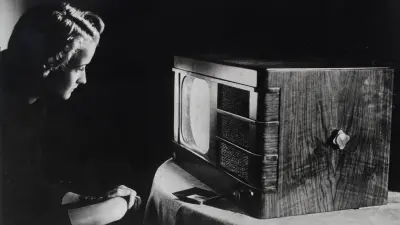
Fernseh GmbH got a fresh start in Darmstadt in 1949, when the Allied forces occupying Germany allowed activity in the television segment. From its new location near the Fernmeldetechnisches Zentralamt (the central office responsible for telecommunications), the local technical university, and radio device manufacturer Blaupunkt, also a Bosch subsidiary, Fernseh GmbH resumed its work. Fernseh AG had supplied the necessary equipment for the television studio operated by Reichspost-Fernsehgesellschaft, the German national television corporation, back in 1938: new iconoscope cameras that used an electronic camera tube instead of mechanical scanning via a Nipkow disk, mechanical and electronic film scanners, and the equipment needed for the control room, including video control units and a video mixing desk. The first big order of the postwar period saw Fernseh GmbH developing the test studio for public broadcaster Nordwestdeutscher Rundfunk (NWDR), with all its basic equipment. This set the stage for the company’s future activities, which involved developing and producing all of the devices that made up a television studio, including the mobile equipment for television trucks. Blaupunkt took on responsibility for receivers.
Color finally arrives
Attempts to transmit television images in color had been made as far back as the early phase of television. The first regular color broadcasts were launched in the United States in October 1953. Color television sets remained very expensive for a long time, so few programs were offered in color at first. Electronic components became more and more popular starting in the 1960s, even as color television systems were being refined and further developed. That meant that many countries faced a double shift in the late 1960s: to smaller, more powerful studio equipment on the one hand, and to color TV on the other. Fernseh GmbH had supplied a large portion of the equipment for the color television test lab used by broadcaster Westdeutscher Rundfunk (WDR) in Cologne in 1963 and had made a name for itself in Germany and beyond through its fundamental research on color television.
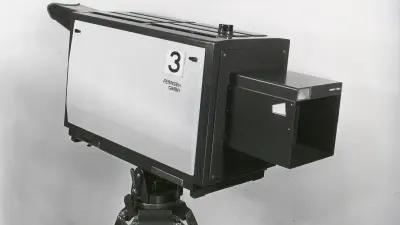
Live from the stadium
Color television — and with it, Fernseh GmbH — made a big leap with the worldwide transmission of the 1972 Olympics in Munich. With live broadcasts scheduled almost throughout the event and very stringent technical requirements to meet, specialists already started calling the event the TV Olympics beforehand. The company, renamed Robert Bosch Fernsehanlagen GmbH (“Fernseh” for short) in 1972, was instrumental in planning the technical implementation of the transmissions and supplying the equipment and setting up the studios. Fernseh supplied the television control room with the switching and distribution system that 60 television broadcasters used to put together their programming for 98 countries.
It set up 12 color TV studios for the broadcasters’ own reporting, sent 25 production trucks with mobile studios and seven television trucks to the events, and supplied 120 color television cameras and additional portable cameras for reporters.
A large portion of the color television equipment used for subsequent major international television events, such as the 1974 World Cup in Germany, the 1976 Olympics in Montreal, and the 1978 World Cup in Argentina, also came from Darmstadt-based Robert Bosch Fernsehanlagen GmbH.
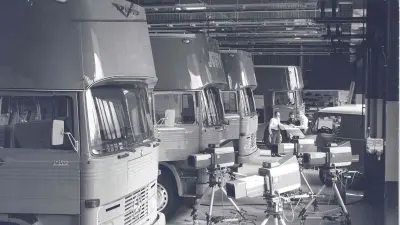
The 1980s brought tough times for the Bosch subsidiary. To hold its own against stiffer competition from the United States, and especially from Japan, Robert Bosch Fernsehanlagen GmbH and the studio equipment segment of Netherlands-based Philips N.V. joined forces in 1986 to form a joint venture called BTS Broadcast Television Systems.
After a gradual retreat, Bosch finally exited the television business in 1993, and Philips acquired the remaining shares in BTS.
That brought the television equipment chapter to a close at Bosch, but Fernseh’s contributions to many technical advances remain an important part of the history of television in the 20thcentury.
Author: Bettina Simon

